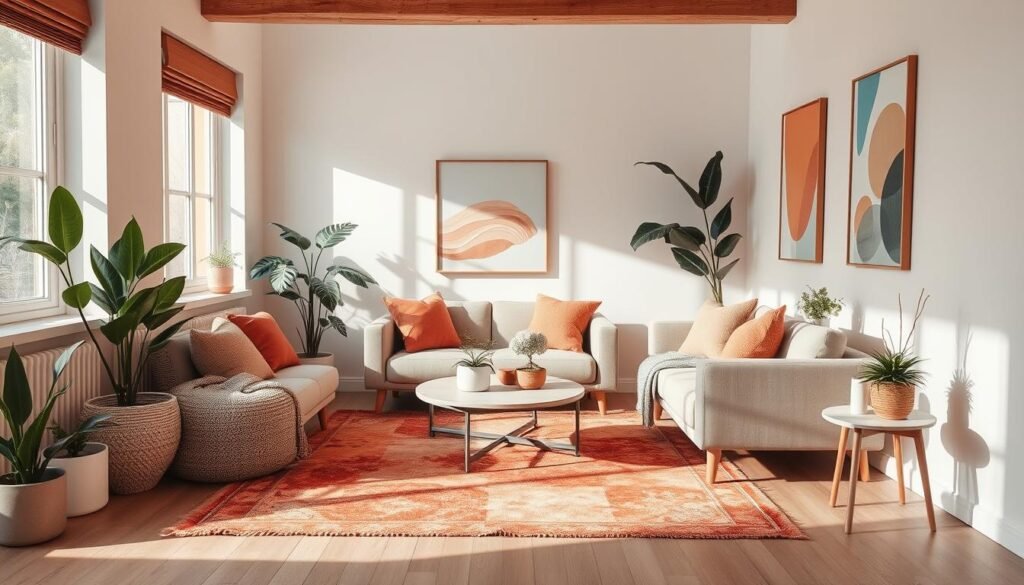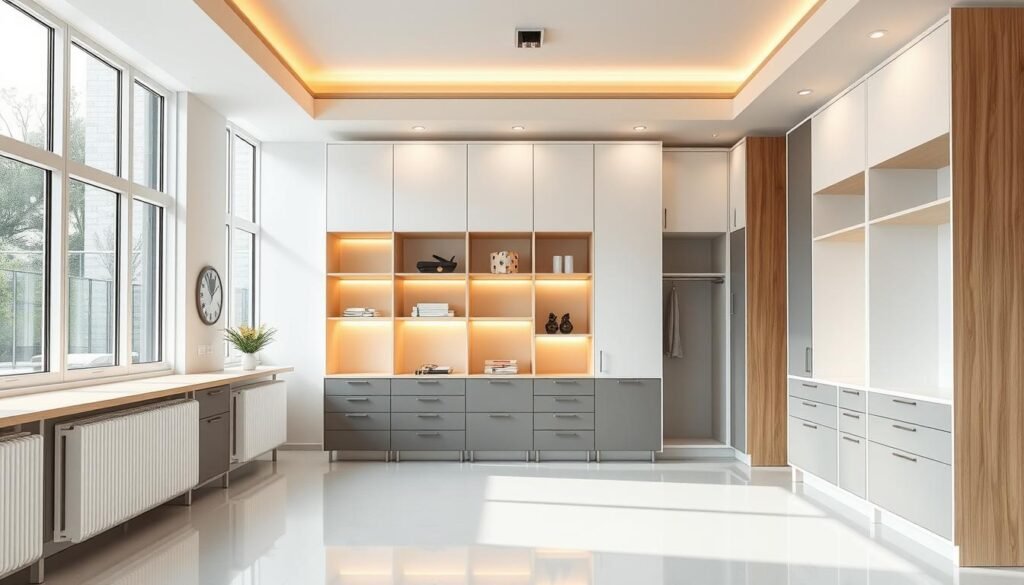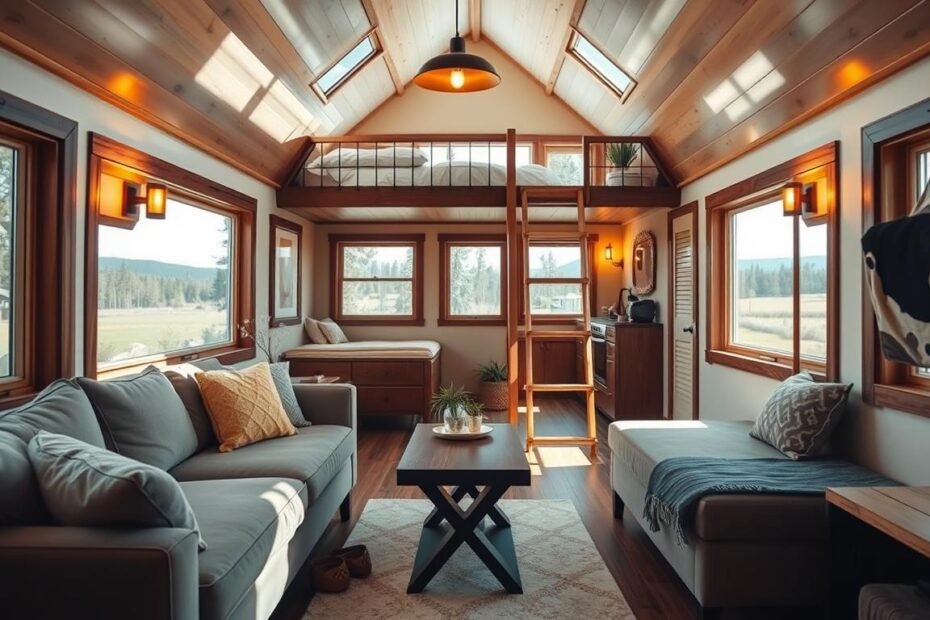Living in a compact home can be challenging, especially when it comes to decorating. The struggle is real: how to make the most of the limited square footage without feeling claustrophobic.
Visual tricks and smart decor choices can make a significant difference. By implementing a few simple strategies, you can create the illusion of more space, making your home feel more livable and comfortable.
Whether you’re dealing with a cozy apartment or a tiny home, this article will explore the best ways to maximize space and enhance your living area with effective small space decor ideas.
Key Takeaways
- Simple visual tricks to create the illusion of more space
- Smart decor choices to enhance your living area
- Effective strategies for maximizing space in tiny homes
- Practical tips for making the most of limited square footage
- Ideas for creating a comfortable and livable home
Understanding the Importance of Space in Small Homes
The feel of a small space is not just about its physical dimensions, but also about how we perceive it. Our brains process the environment based on various cues, including lighting, color, and layout, which can either make a space feel cramped or expansive.
How Perception Influences Space
The way we perceive a small space can significantly impact its functionality. For instance, a well-organized room can feel larger because it reduces visual clutter. Efficient small space design involves creating an illusion of more space by using certain techniques such as minimizing furniture and maximizing the use of natural light.
- Minimize clutter to create a sense of openness
- Use mirrors to reflect light and images, making the space feel larger
- Select furniture that serves multiple purposes
The Role of Lighting
Lighting is a crucial element in making a small space feel bigger. It not only illuminates the area but also creates an illusion of more space. Recessed spot lighting is particularly effective as it is visually appealing and doesn’t occupy valuable surface space. Additionally, installing sconces can add brightness without cluttering the room.
Some effective space-saving tips include using layered lighting, which involves a combination of overhead lighting, table lamps, and floor lamps to create a bright and welcoming atmosphere. This approach not only enhances the ambiance but also makes the space feel more expansive.
Choosing the Right Color Palette
In small homes, the choice of color palette can either enhance or detract from the sense of spaciousness. The colors you choose for your walls, furniture, and decor can significantly influence how large or small your space feels.
When deciding on a color scheme, one of the primary considerations is the balance between light and dark colors.
Light Colors vs. Dark Colors
For the illusion of a larger room, using a light color scheme is highly effective. Pastels, neutrals, shades of cream, and white are all excellent color possibilities that can make a room feel more spacious. Light colors tend to reflect light, making the space feel brighter and more expansive.
In contrast, dark colors can make a room feel cozy but also smaller. However, this doesn’t mean you can’t use dark colors at all. Strategic use of dark shades on certain elements, like furniture or accent pieces, can add depth without overwhelming the space.
Accent Walls for Depth
Creating an accent wall is a great way to add depth to a room without making it feel smaller. By choosing a color that’s different from the rest of the walls, you can create a focal point that draws the eye and adds visual interest.
To maximize the sense of space, consider the following tips:
- Choose a light color for the majority of the walls.
- Select a slightly darker or bolder shade for the accent wall.
- Ensure the accent wall doesn’t overwhelm the space.
Another effective strategy is to adopt a tone-on-tone approach. Choosing furniture in a similar color to the walls helps it blend in and take up less visual space, contributing to a sense of spaciousness.

By thoughtfully selecting your color palette and considering the interplay between different shades, you can significantly enhance the feeling of spaciousness in your home.
Smart Furniture Choices for Tiny Homes
The challenge of furnishing a tiny home lies in choosing furniture that maximizes space without compromising on style. When every square foot counts, it’s essential to opt for furniture that serves more than one purpose.
Multi-functional furniture is a game-changer for tiny homes. Pieces like a storage ottoman or a coffee table with storage can significantly reduce clutter. For instance, a sofa bed is not only a comfortable seating option but also a convenient sleeping solution for guests.
Multi-Functional Furniture
Investing in multi-functional furniture is a practical approach to tiny home living. Examples include:
- Desks with built-in shelving
- Nesting tables that can be easily stored
- Murphy beds that fold up against the wall
These pieces help maintain a clutter-free environment while providing the necessary functionality.
Space-Saving Solutions
Choosing furniture that doesn’t visually clutter the space is equally important. Opting for glass tables, acrylic chairs, or lucite pieces can make a room feel more spacious. The transparency of these materials creates a sense of openness, contributing to a more airy feel.
As the saying goes, “less is more.” Opting for fewer, larger pieces over a bunch of smaller items will make your space feel bigger and less cluttered. This principle is particularly relevant when selecting furniture for tiny homes.
By incorporating smart furniture choices, tiny home residents can enjoy a more spacious and comfortable living environment. The key is to be intentional with each piece, ensuring it adds value without compromising on style or functionality.
Creative Storage Ideas to Maximize Space
Smart storage solutions can significantly enhance the livability of compact spaces. In small homes, effective storage is crucial for maintaining a clutter-free environment and making the most of the available space.
Utilizing Vertical Storage
One of the most effective ways to maximize space is by utilizing vertical storage. This involves using wall-mounted shelves, storage units, or hooks to keep items off the floor and out of the way.
- Install shelves or storage units that go up to the ceiling to maximize vertical space.
- Use wall-mounted hooks for hanging items like bikes, bags, or accessories.
- Opt for tall, narrow storage units that fit into tight spaces.

Under-Bed Storage Options
Under-bed storage is another clever way to utilize dead space in small homes. By using under-bed storage containers or drawers, you can keep items like linens, out-of-season clothes, or luggage organized and out of the way.
“Invest in smart storage. Use a trunk or a storage ottoman as a coffee table. It can also do double duty to hold blankets, remotes, books, photo albums, etc.”
Some popular under-bed storage options include:
- Under-bed drawers that can be custom-built or purchased as ready-made units.
- Storage bins or containers that can be easily slid under the bed.
- Bed risers that create additional space under the bed for storage.
Hanging Organizers for Efficiency
Hanging organizers are a great way to maximize closet space and keep items like clothes, bags, or accessories organized. You can use over-the-door organizers, hanging rods with multiple levels, or shoe organizers.
| Organizer Type | Description | Benefits |
|---|---|---|
| Over-the-door organizers | Hanging organizers that fit over the door | Maximizes closet space, easy to install |
| Hanging rods with multiple levels | Rods that provide multiple hanging levels | Increases hanging space, keeps clothes organized |
| Shoe organizers | Organizers with pockets for shoes | Keeps shoes organized, maximizes closet space |
By incorporating these creative storage ideas into your small home, you can maximize space, reduce clutter, and enhance the overall livability of your compact space.
Decor Techniques to Enhance Small Spaces
Transforming a small space into a spacious and welcoming area requires thoughtful decor techniques. By incorporating a few simple strategies, you can create the illusion of more space and enhance the overall aesthetic of your home.
Creating Illusions with Mirrors
Using mirrors everywhere is a simple yet effective way to make a room feel more spacious. They bounce light around the room, creating an illusion of larger space. This technique is particularly effective in small homes where natural light is limited.
Simplifying with Minimalist Design
Simplifying the color scheme is another effective decor technique for small spaces. Adopting a monochromatic color scheme for walls, furniture, and accessories can create a sense of continuity and openness. This minimalist living idea helps to maintain a clutter-free environment, making the space feel larger.
Open Shelving for a Spacious Feel
Incorporating open shelving into your small space decor can also contribute to a sense of spaciousness. By displaying items on open shelves, you can create a sense of depth and visual interest, drawing the eye outward and making the space feel larger.
FAQ
What are some effective ways to make a small space feel larger?
Using visual tricks, smart decor choices, and maximizing space can make a small area feel more spacious. This includes strategies like using light colors, multi-functional furniture, and creative storage solutions.
How does lighting impact the feel of a small space?
Lighting can significantly impact the feel of a small space. Strategies like recessed lighting and sconces can make a room feel more spacious by creating a sense of openness and reducing visual clutter.
What color palette is best for small spaces?
Light colors are generally best for small spaces as they can create a sense of spaciousness. Using a monochromatic color scheme or incorporating accent walls can also enhance the feel of a small space.
How can I choose furniture that maximizes space in my tiny home?
Selecting multi-functional furniture, space-saving solutions, and pieces that don’t visually clutter the space can help maximize space. Consider furniture with storage, foldable pieces, or items that serve more than one purpose.
What are some creative storage solutions for small spaces?
Utilizing vertical storage, under-bed storage, and hanging organizers can help maximize space. Smart storage solutions are essential for maintaining a clutter-free and spacious environment.
How can mirrors be used to create the illusion of more space?
Mirrors can be used to create the illusion of more space by reflecting light and images, making a room feel larger. Strategically placing mirrors opposite windows or using a large mirror can enhance this effect.
What are the benefits of open shelving in small spaces?
Open shelving can make a small space feel more open and airy by reducing visual clutter. It also provides an opportunity to display decorative items, adding to the aesthetic appeal of the space.
How can I apply minimalist design principles to my small space?
Minimalist design principles emphasize simplicity and reducing clutter. By using a limited color palette, selecting a few statement pieces, and avoiding unnecessary decor, you can maintain a sense of openness and simplicity in your small space.
What are some efficient small space design ideas?
Efficient small space design ideas include using multi-functional furniture, incorporating smart storage solutions, and applying minimalist design principles. These strategies can help maximize space and create a more spacious feel.
